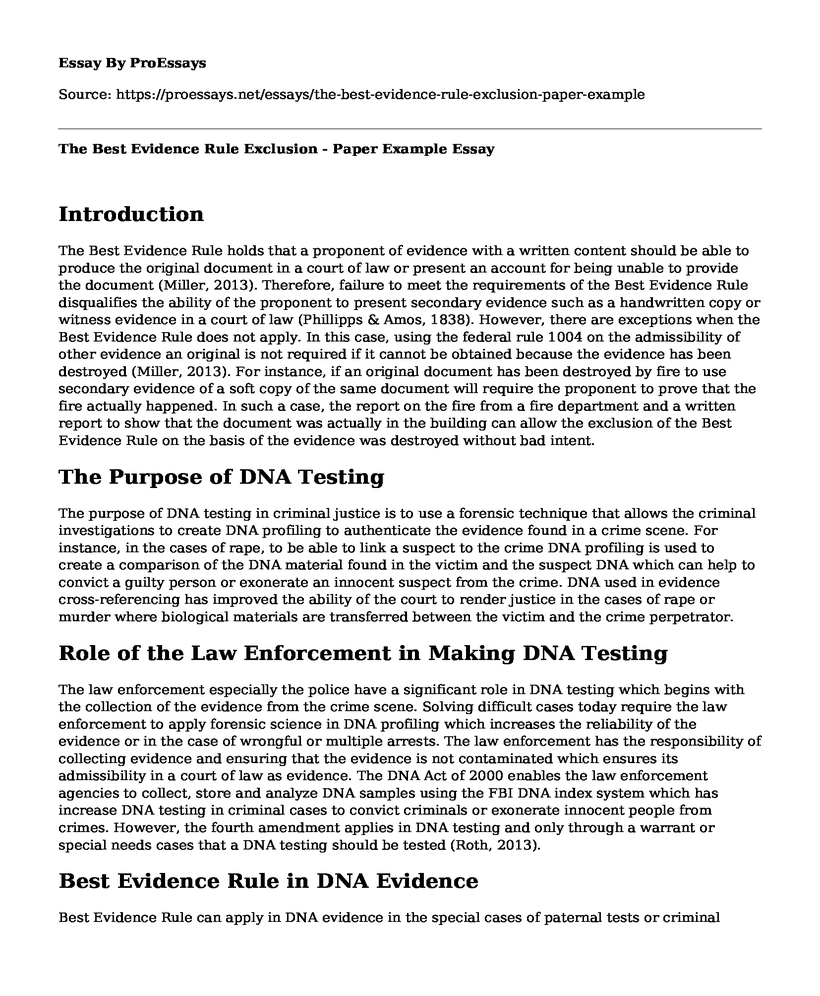Introduction
The Best Evidence Rule holds that a proponent of evidence with a written content should be able to produce the original document in a court of law or present an account for being unable to provide the document (Miller, 2013). Therefore, failure to meet the requirements of the Best Evidence Rule disqualifies the ability of the proponent to present secondary evidence such as a handwritten copy or witness evidence in a court of law (Phillipps & Amos, 1838). However, there are exceptions when the Best Evidence Rule does not apply. In this case, using the federal rule 1004 on the admissibility of other evidence an original is not required if it cannot be obtained because the evidence has been destroyed (Miller, 2013). For instance, if an original document has been destroyed by fire to use secondary evidence of a soft copy of the same document will require the proponent to prove that the fire actually happened. In such a case, the report on the fire from a fire department and a written report to show that the document was actually in the building can allow the exclusion of the Best Evidence Rule on the basis of the evidence was destroyed without bad intent.
The Purpose of DNA Testing
The purpose of DNA testing in criminal justice is to use a forensic technique that allows the criminal investigations to create DNA profiling to authenticate the evidence found in a crime scene. For instance, in the cases of rape, to be able to link a suspect to the crime DNA profiling is used to create a comparison of the DNA material found in the victim and the suspect DNA which can help to convict a guilty person or exonerate an innocent suspect from the crime. DNA used in evidence cross-referencing has improved the ability of the court to render justice in the cases of rape or murder where biological materials are transferred between the victim and the crime perpetrator.
Role of the Law Enforcement in Making DNA Testing
The law enforcement especially the police have a significant role in DNA testing which begins with the collection of the evidence from the crime scene. Solving difficult cases today require the law enforcement to apply forensic science in DNA profiling which increases the reliability of the evidence or in the case of wrongful or multiple arrests. The law enforcement has the responsibility of collecting evidence and ensuring that the evidence is not contaminated which ensures its admissibility in a court of law as evidence. The DNA Act of 2000 enables the law enforcement agencies to collect, store and analyze DNA samples using the FBI DNA index system which has increase DNA testing in criminal cases to convict criminals or exonerate innocent people from crimes. However, the fourth amendment applies in DNA testing and only through a warrant or special needs cases that a DNA testing should be tested (Roth, 2013).
Best Evidence Rule in DNA Evidence
Best Evidence Rule can apply in DNA evidence in the special cases of paternal tests or criminal cross-referencing (Roth, 2013). The court can request DNA testing in which the results are recorded in the form of writing as well as photocopies of the primary results. In such circumstances, the primary evidence filed when the results were taken fits the description of the Best Evidence Rule and can be used in a court of law. On the other hand, the photocopies of the records from the DNA testing results can only be admissible as scientific evidence in the absence of the primary written findings on the basis provided by Best Evidence Rule exclusion.
References
Miller, C. (2013). Evidence: Best Evidence Rule, Version One. Place of publication not identified: CALI eLangdell Press.
Phillipps, S. M., & Amos, A. (1838). A treatise on the law of evidence. London: Saunders and Benning.
Roth, A. (2013). Maryland v. King and the wonderful, horrible DNA revolution in law enforcement. Ohio St. J. Crim. L., 11, 295.
Cite this page
The Best Evidence Rule Exclusion - Paper Example. (2022, Jul 11). Retrieved from https://proessays.net/essays/the-best-evidence-rule-exclusion-paper-example
If you are the original author of this essay and no longer wish to have it published on the ProEssays website, please click below to request its removal:
- The Most Recent Trends in Sentencing - Paper Example
- Research Paper on Psychopathy and Crimes
- Expository Essay on Intellectual Property Theft
- Juvenile Crime: A Growing Concern for Embark Community? - Essay Sample
- The Letter from Birmingham Jail Analysis Essay
- Essay Example on Marijuana Legalization: A Century-long Debate
- Essay Sample on Children & Police







